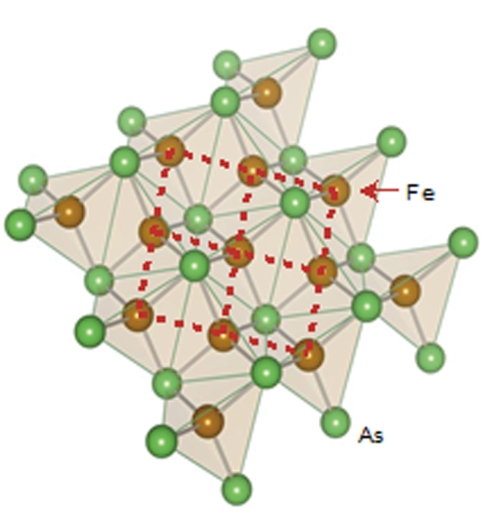
Layered look: iron (brown) and arsenic (green) atoms in the conducting layer of a pnictide.
By Hamish Johnston
High-temperature (high-Tc) superconductivity has given hope and heartbreak in equal measure to physicists since the phenomenon was first discovered in 1986.
The hope is two-fold: that we will soon understand why superconductivity arises in this complex group of materials; and that this knowledge will lead us to a material that is a superconductor at room temperature. The former would be a triumph of the physics of highly correlated systems and the latter would spark a technological revolution.
Over the past 30 years nature has thrown up a large number of high-Tc materials for researchers to study. But despite the huge effort into trying to understand the mechanism (or mechanisms) that allow superconductivity to endure at temperatures as high as 135 K, a breakthrough in our understanding of the underlying physics remains elusive. Adding to the heartbreak is that the discovery of new high-Tc materials often makes the problem appear more complicated, rather than simplifying it.
Perhaps the most unexpected discovery in recent years is that some members of a group of materials called the iron pnictides are high-Tc superconductors. These are layered materials, with a typical example containing planes of iron and arsenic atoms that alternate with planes of lanthanum and oxygen. While other high-Tc materials also have complicated multi-atom structures, pnictides are unique because they contain iron – which is strongly ferromagnetic and was previously thought to be incompatible with superconductivity. This is a classic example of how a discovery can further muddy the waters as well as offer hope.
Iron pnictide superconductors were first discovered in 2008 by Hideo Hosono and colleagues at the Tokyo Institute of Technology. Hosono and eight colleagues have now published a review article in Science and Technology of Advanced Materials that describes the results of a four-year research project that was funded by the Japanese government to explore new superconducting materials including iron pnictides.
The article can be read free of charge and is called “Exploration of new superconductors and functional materials, and fabrication of superconducting tapes and wires of iron pnictides”. Table 2 of the article is a perfect example of the challenge facing physicists trying to understand high-Tc superconductivity – it lists about 1000 materials that were considered in the study.
Earlier this year Hosono and Hideo Aoki of the University of Tokyo wrote an article for Physics World about iron-based superconductors. It is called “A superconducting surprise comes of age” and appeared in the February 2015 issue of the magazine.
If you’re a member of the Institute of Physics (IOP), you can get immediate access to the article with the digital edition of the magazine on your desktop via MyIOP.org or on any iOS or Android smartphone or tablet via the Physics World app, available from the App Store and Google Play. If you’re not yet in the IOP, you can join as an IOPimember for just £15, €20 or $25 a year to get full digital access to Physics World.
Testing methodically about 1700 materials for the Tc-superconductivity is indeed, an enormous task. However, there does not seem any tangible sign/route from this work towards achieving the room Tc-supercoductivity.
Trackback: Physics Viewpoint | Exploring the expanding world of high-temperature superconductors